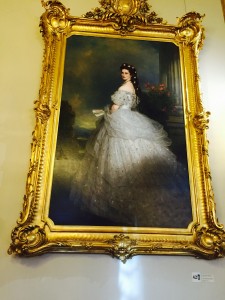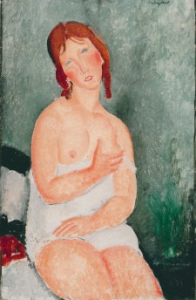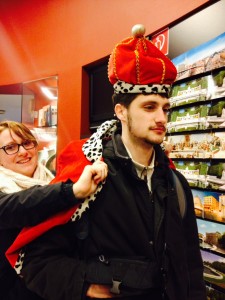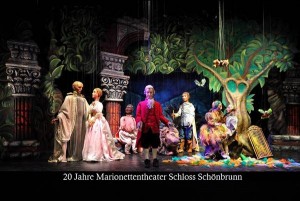In the second part of our Vienna Blog, read about the Wiener Schatzkammer, the Marionette Theater and a performance of Mozart’s Magic Flute, the Sisi Museum, and the Albertina.
Wiener Schatzkammer
by Ezra Sassaman
One part of Vienna which I enjoyed immensely was the treasure chamber, or Schatzkammer. This is one area in which the United States does not offer much: back at home for me, it would be impossible to find this amount of royal adornments or anything at all from this far into history. The treasures in the rooms were like something I had only ever seen in books or movies and I couldn’t believe they were real at first—I felt like I was in the storage room of a theater.
Included in the cache were huge portraits of former Austrian royalty, the Habsburgers, resplendent garments, bejeweled crowns and swords, and even some things I had never imagined, like a much too intricate cradle for a baby Habsburger and an amazing pitcher for the official baptism of royalty. Among the portraits was a painting of Maria Louise, one of Napoleon’s wives. Of course, we hear about Napoleon, but I have the feeling I did not fully grasp that he was a real person—it had always seemed like a story from the past that we did not have much connection to in the present. In the Schatzkammer, however, seeing these portraits and treasures which belonged to these people from so long ago was simply different than seeing pictures or reading about historical events—these figures of history began to come to life for me.
Toward the end of the tour, I needed to ask a question. We often see criminal masterminds trying to break into exhibits like the Schatzkammer in shows like “Sherlock” or movies like “National Treasure.” I asked the tour guide what kind of security measures the Schatzkammer used, and if there had been any attempts to steal the priceless treasures. “Well, of course I can’t tell you exactly what kind of security we use” laughed the tour guide—“are you trying to steal something?” She said that there had been no break-in attempts at the Schatzkammer, but a painting had been stolen from a neighboring museum during construction. The thief had tried to blackmail the museum, but they caught him.
Magic Flute Marionette Theater at Schönbrunn Palace
by Santiago Princ
During our excursion to Vienna we were taken to multiple theater plays and different kind of performances, one of them being a rare Marionette depiction of “The Magic Flute” (“Die Zauberflöte” in German); a two-act opera by Wolfgang Amadeus Mozart. What I found most remarkable about the experience was the amazingly honed skill that the puppeteers had to control the marionettes. This play normally performed by human beings lacked no fluidity or expression while being performed by the stringed dolls. The movements of the dolls were perfectly synchronized with their dialogs, every scene flowed smoothly and the fact that these were puppets being controlled instead of humans made “special effects” such as Papageno quasi-flying great addition to the play’s fantasy. We were also given some insights on the art of puppeteering. According to the professionals in the theater every single action of the puppet such as walking, waving or striking a pose can take years to master, and becoming proficient at puppeteering can be as demanding as becoming a professional instrument player. During the intermission we could also see how the design and making process of the marionettes develops and after the play we were invited by the puppeteers to see how they operate from behind the scenes. I found this to be a very peculiar and hilarious experience!
Sisi Museum
by Cassandra Blyler
A few o f us chose to visit the Sisi Museum, which is located in part of the Hofburg Palace. The museum was organized into two sections; the first being a collection of silverware, plates, and other household items made specifically for the Habsburgs. I found this part of the museum to be impressive due to the sheer quantity of various items; for example a collection of 200 golden plates only occupied a tiny section. The second half of the museum was dedicated to the life of Empress Elizabeth (Sisi) who was married to Franz Joseph I. This part of the museum was very interesting because it provided us with so much information about Sisi’s personal life. It included excerpts of poems she had written, along with dresses and other articles of clothing she had worn in private. I was amazed by the circumference of her waist and the corsets used to further exaggerate its smallness. It was also noteworthy to see the highly popularized paintings of Sisi in their original form. It was interesting to hear about the daily-life struggles of someone in the royal family; those makes her more relatable, especially with her depression following the suicide of her son.
f us chose to visit the Sisi Museum, which is located in part of the Hofburg Palace. The museum was organized into two sections; the first being a collection of silverware, plates, and other household items made specifically for the Habsburgs. I found this part of the museum to be impressive due to the sheer quantity of various items; for example a collection of 200 golden plates only occupied a tiny section. The second half of the museum was dedicated to the life of Empress Elizabeth (Sisi) who was married to Franz Joseph I. This part of the museum was very interesting because it provided us with so much information about Sisi’s personal life. It included excerpts of poems she had written, along with dresses and other articles of clothing she had worn in private. I was amazed by the circumference of her waist and the corsets used to further exaggerate its smallness. It was also noteworthy to see the highly popularized paintings of Sisi in their original form. It was interesting to hear about the daily-life struggles of someone in the royal family; those makes her more relatable, especially with her depression following the suicide of her son.
Albertina
by George DeRosa
“For about six hours, entranced, S. A. Powers had watched thousands of Picasso paintings replace one another at flashcut speed, and then he had been treated to Paul Klees, more than the painter had painted during his entire lifetime. S. A. Powers, now viewing Modigliani paintings replace themselves at furious velocity, had conjectured (one needs a theory for everything) that the Rosicrucians were telepathically beaming pictures at him, probably boosted by microrelay systems of an advanced order; but then, when Kandinsky paintings began to harass him, he recalled that the main art museum at Leningrad specialized in just such nonobjective moderns, and decided that the Soviets were attempting telepathically to contact him.”
After four days of travelling around Vienna, coffee was no longer a tasty pick-me-up but rather a necessity. After touring the Belvedere Palace and Museum, the rest of the afternoon was free and I eagerly retraced my steps through the city towards my bed. Along the way, I was remarking to myself how odd it is seeing buildings and cathedrals from the 12th century directly across the street from ultra-modern boutiques selling handbags and skin creams but sleep was the only relevant thought on my mind. As I pulled the door handle of the hotel expecting entrance into my own personal nirvana I was snapped back into reality when the door wouldn’t budge. I was locked out. Santiago had the keys. Scheiße. With no means of contacting Santiago, I quickly surveyed my options and did the only rational thing left to do: I took the nearest subway in a completely random direction. Upon exiting the subway, I found myself in Schillerplatz and the accompanying park memorializing the life of German poet, philosopher, historian, and playwright Friedrich Schiller. After a tour around the park I found myself outside of the Albertina Museum and decided to view their exhibitions.
That lovely excerpt from Phillip K. Dick’s, A Scanner Darkly, was my first exposure to what would be considered “High Art” and whether it was Synchronicity, the Russians, or the fact that the Albertina Museum is home to over 1,000,000 prints and over 65,000 drawings (one needs a theory for everything), I was pleased to find that one of the first paintings I had chosen to spend time with, upon further inspection, was Amedeo Modigliani’s Young Woman in a Blue Shirt. Seeing Modigliani’s name conjured up memories of that particular passage from Dick’s text and gave me a sense of familiarity and connectedness in a completely foreign city and country. After spending another 10 minutes trying to unlock the secrets hidden behind her solid blue eyes I moved on to the rest of the museum. I was greeted by works of artists with familiar names such as Monet, Picasso, Kandinsky, and works by artists less familiar to me such as Redon, Delvaux, and Giacometti. The Albertina is one of my fondest memories of Vienna not only because of the events leading up to it but also because after leaving I felt ever slightly more cultured.
K. Dick’s, A Scanner Darkly, was my first exposure to what would be considered “High Art” and whether it was Synchronicity, the Russians, or the fact that the Albertina Museum is home to over 1,000,000 prints and over 65,000 drawings (one needs a theory for everything), I was pleased to find that one of the first paintings I had chosen to spend time with, upon further inspection, was Amedeo Modigliani’s Young Woman in a Blue Shirt. Seeing Modigliani’s name conjured up memories of that particular passage from Dick’s text and gave me a sense of familiarity and connectedness in a completely foreign city and country. After spending another 10 minutes trying to unlock the secrets hidden behind her solid blue eyes I moved on to the rest of the museum. I was greeted by works of artists with familiar names such as Monet, Picasso, Kandinsky, and works by artists less familiar to me such as Redon, Delvaux, and Giacometti. The Albertina is one of my fondest memories of Vienna not only because of the events leading up to it but also because after leaving I felt ever slightly more cultured.


